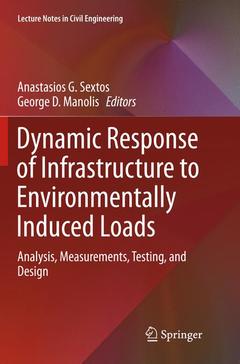Description
Dynamic Response of Infrastructure to Environmentally Induced Loads, Softcover reprint of the original 1st ed. 2017
Analysis, Measurements, Testing, and Design
Lecture Notes in Civil Engineering Series, Vol. 2
Coordinators: Sextos Anastasios G., Manolis George D.
Language: English
Subject for Dynamic Response of Infrastructure to Environmentally...:
Dynamic Response of Infrastructure to Environmentally Induced Loads
Publication date: 05-2018
Support: Print on demand
Publication date: 05-2018
Support: Print on demand
Dynamic Response of Infrastructure to Environmentally Induced Loads
Publication date: 05-2017
Support: Print on demand
Publication date: 05-2017
Support: Print on demand
Description
/li>Contents
/li>Comment
/li>
This book provides state of the art coverage of important current issues in the analysis, measurement, and monitoring of the dynamic response of infrastructure to environmental loads, including those induced by earthquake motion and differential soil settlement. The coverage is in five parts that address numerical methods in structural dynamics, soil?structure interaction analysis, instrumentation and structural health monitoring, hybrid experimental mechanics, and structural health monitoring for bridges. Examples that give an impression of the scope of the topics discussed include the seismic analysis of bridges, soft computing in earthquake engineering, use of hybrid methods for soil?structure interaction analysis, effects of local site conditions on the inelastic dynamic analysis of bridges, embedded models in wireless sensor networks for structural health monitoring, recent developments in seismic simulation methods, and seismic performance assessment and retrofit of structures. Throughout, the emphasis is on the most significant recent advances and new material. The book comprises extended versions of contributions delivered at the DE-GRIE Lab Workshop 2014, held in Thessaloniki, Greece, in November 2014.
Influence of seismic wave angle of incidence over the response of long curved bridges considering soil-structure-interaction.- Alternative approaches to the seismic analysis of R/C bridges.- Multi-platform hybrid (experimental-analysis) simulations.- Field structural dynamic tests at the Volvi, Greece, European test-site.- An intercontinental hybrid simulation experiment for the purposes of seismic assessment of a three-span R/C bridge.- Experimental seismic assessment of the effectiveness of isolation techniques for the seismic protection of existing R/C Bridges.- Modeling of high damping rubber bearings.- Experimental methods and activities in support of earthquake engineering.- Time reversal and imaging for structures.- Decentralized infrastructure health monitoring using embedded computing in wireless sensor networks.- Effects of local site conditions on the inelastic dynamic response of R/C bridges.- BEM-FEM coupling in the time domain for soil-tunnel interaction.- Energy methods for assessing dynamic soil-structure-interaction response in buildings.- Numerical and experimental identification of soil–foundation-bridge system dynamic characteristics.- Quantification of the seismic collapse capacity of regular frame structures.
Provides state of the art information on structural monitoring and remote sensing Describes progress in the numerical modelling of bridges Presents new material on practical inverse analysis for establishing the structural health of infrastructure Describes advances in hybrid testing methods for soil–structure interaction analysis Includes supplementary material: sn.pub/extras
© 2024 LAVOISIER S.A.S.




